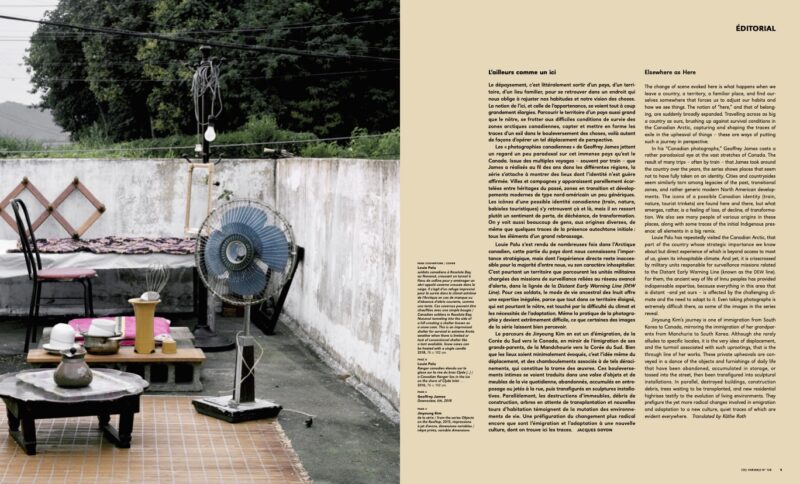[Winter 2025]
Editorial
by Jacques Doyon
The change of scene evoked here is what happens when we leave a country, a territory, a familiar place, and find ourselves somewhere that forces us to adjust our habits and how we see things. The notion of “here,” and that of belonging, are suddenly broadly expanded. Travelling across as big a country as ours, brushing up against survival conditions in the Canadian Arctic, capturing and shaping the traces of exile in the upheaval of things – these are ways of putting such a journey in perspective.
In his “Canadian photographs,” Geoffrey James casts a rather paradoxical eye at the vast stretches of Canada. The result of many trips – often by train – that James took around the country over the years, the series shows places that seem not to have fully taken on an identity. Cities and countrysides seem similarly torn among legacies of the past, transitional zones, and rather generic modern North American developments. The icons of a possible Canadian identity (train, nature, tourist trinkets) are found here and there, but what emerges, rather, is a feeling of loss, of decline, of transformation. We also see many people of various origins in these places, along with some traces of the initial Indigenous presence: all elements in a big remix.
Louie Palu has repeatedly visited the Canadian Arctic, that part of the country whose strategic importance we know about but direct experience of which is beyond access to most of us, given its inhospitable climate. And yet, it is crisscrossed by military units responsible for surveillance missions related to the Distant Early Warning Line (known as the DEW Line). For them, the ancient way of life of Innu peoples has provided indispensable expertise, because everything in this area that is distant –and yet ours – is affected by the challenging climate and the need to adapt to it. Even taking photographs is extremely difficult there, as some of the images in the series reveal.
Jinyoung Kim’s journey is one of immigration from South Korea to Canada, mirroring the immigration of her grandparents from Manchuria to South Korea. Although she rarely alludes to specific locales, it is the very idea of displacement, and the turmoil associated with such uprootings, that is the through line of her works. These private upheavals are conveyed in a dance of the objects and furnishings of daily life that have been abandoned, accumulated in storage, or tossed into the street, then been transfigured into sculptural installations. In parallel, destroyed buildings, construction debris, trees waiting to be transplanted, and new residential highrises testify to the evolution of living environments. They prefigure the yet more radical changes involved in emigration and adaptation to a new culture, quiet traces of which are evident everywhere. Translated by Käthe Roth
[ Complete issue, in print and digital version, available here: Ciel variable 128 – CHANGE OF SCENE ] [ Complete article in digital version available here: Elsewhere as Here]

